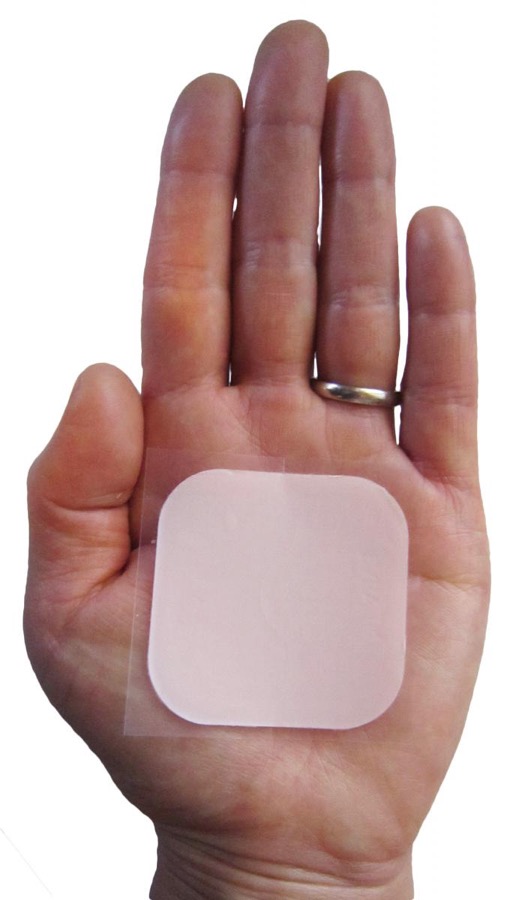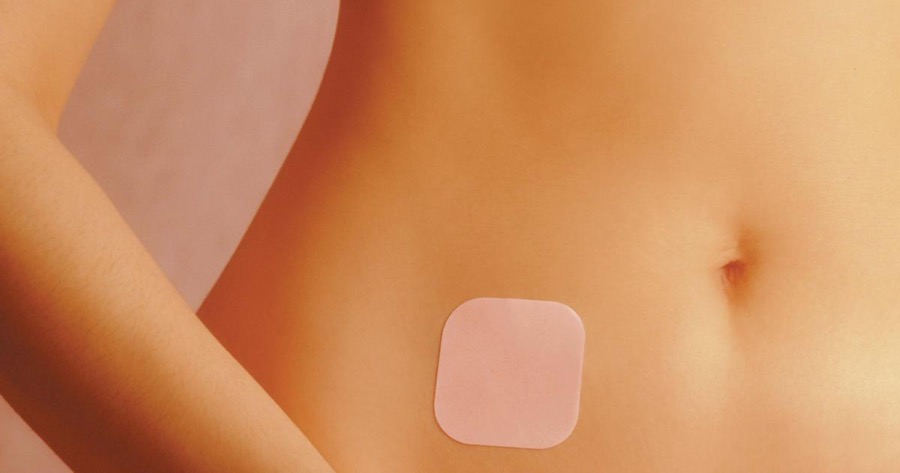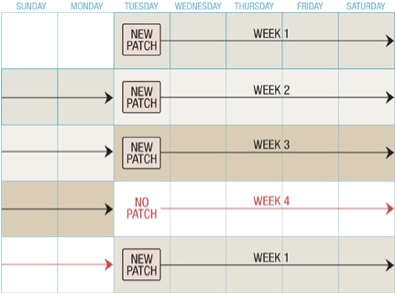Table of Contents
What Is the Contraceptive Patch?

The contraceptive patch (also known as birth control patch) is a waterproof, thin, beige, plastic patch that is applied to the skin to prevent pregnancy.1 The patch can be worn on the lower abdomen, buttocks, or upper body.2 A new patch is placed on the skin once a week for three weeks followed by a patch-free week.1 The patch is small and smooth so it can be easily worn under clothing without being noticed.
The patch works by releasing a combination of the hormones estrogen and progestin into the bloodstream.3 These are the same hormones used in the combination birth control pill. Estrogen and progestin prevent ovulation and make cervical mucus thicker.1 Pregnancy cannot occur if an egg has not been released. Thicker cervical mucus keeps sperm from reaching the egg.

The contraceptive patch prevents pregnancy over 99% of the time when used consistently and as directed.1 With inconsistent use, the contraceptive patch prevents pregnancy about 91% of the time.1,5
Cost
In the United States, the contraceptive patch is only available with a prescription. It can be purchased from a pharmacy or clinic for $0 to $80 depending on insurance coverage.1 For information about receiving a prescription for the contraceptive patch, contact your healthcare provider or your local Planned Parenthood.
Patch Application
The birth control patch is a once-a-week contraceptive. For three weeks, the old patch is discarded at the end of each week and a new patch is applied in a different location (even if the change is simply from the right to left buttock), followed by one patch-free week. It does not matter the time of day the patch is changed.
1. Clean and dry the area of the skin where the patch will be applied. In order to ensure that the patch sticks, do not apply lotion, oil, powder or makeup on the region.
2. Carefully tear the package open and peel the patch and plastic layer off the foil liner.
3. Clear half of the plastic away from the patch and apply the sticky part to the skin.
4. Remove the other half of the plastic and press the entire patch against the skin for ten seconds.
5. After one week, remove the patch on the same day of the week as applied (i.e. remove on Sunday if applied the previous Sunday). Reapply a new patch and repeat for the second and third weeks.
6. Fold the removed patch in half and throw it in the trash, away from children and pets.
During the patch-free week, it is common for a female to begin her menstrual period since no new hormones are introduced during this time. A non-hormonal backup form of contraception, such as condoms, should be used for the first seven days following the initial application in order to prevent pregnancy. Only one patch should be used at a time.


It is not uncommon for mistakes to occur when using the patch. A female may forget to change the patch after a week, forget to put a new one on after a patch-free week, or it may become loose and fall off. If a female forgets to put a new patch on after the patch-free week, she should put a new one on as soon as she remembers and use a backup form of birth control such as a male or female condom.1 If she is less than two days (48 hours) late changing the patch during week two or three, she should change it as soon as she remembers and switch to a new patch on her regular new patch day. If she is more than two days late changing the patch, she should put a new one on as soon as she remembers and wear it for one week before changing to the next patch.1 It is important to use a backup barrier method of contraception, such as a male or female condom, if lack of replacement occurs. If a patch becomes loose or falls off for less than 48 hours, reapply the patch. If it will not stick, a new patch should be applied. If it has been more than 48 hours, a new patch should be applied and this day of the week will become the new patch day.1 A backup method must be used to prevent pregnancy for seven days after the new patch is applied.
Advantages of Using the Contraceptive Patch
There are several advantages to the birth control patch. Unlike the pill, which is taken on a daily basis, the patch is only changed once a week. It can be applied and removed by the female in the privacy of her own home, and its visibility can serve as a personal reminder for application. The patch will also help to maintain sexual spontaneity, since it is applied at a time separate from sexual activity.1 If a female who is using the patch decides she wants try to conceive, her ability to become pregnant returns quickly when use of the patch is stopped.1
Because the patch contains the same hormones as the combination pill, it likely offers the same benefits, including protection against the following:
- acne
- bad menstrual cramps
- bone thinning
- non-cancerous breast growths
- ectopic pregnancy
- endometrial or ovarian cancers
- infection of the ovaries, tubes, and uterus
- iron deficiency anemia
- cysts in the breasts and ovaries
- pelvic inflammatory disease
- other premenstrual symptoms, such as headaches and depressed mood
- heavy and/or irregular periods1
If a female is experiencing any of the issues listed above, the patch may be the right choice for her. For more information about choosing the right birth control method, she should consult her healthcare provider.
Disadvantages of Using the Contraceptive Patch
The patch provides no protection against sexually transmitted infections (STIs). The patch must be used with a male or female condom to prevent the spread of STIs. The patch offers less protection than the pill against ectopic pregnancies. If pregnancy does occur while using the patch, there is an increased risk of ectopic pregnancy.2 An ectopic pregnancy occurs when a fertilized egg implants in an area of the female body outside of the uterus, most commonly in one of the two fallopian tubes. Ectopic pregnancies carry serious risks to the female.2
Because the patch contains the same hormones as the combination pill, it comes with similar risks and side effects, including breast tenderness, bleeding between periods, and nausea or vomiting.1 These side effects usually clear up after two or three months and many females adjust to the patch with few or no problems.

Females who use birth control with estrogen, such as the patch or the combination birth control pill, have an increased risk of rare but serious side effects. These risks include heart attack, stroke, and having a blood clot in the legs, lung, heart, or brain.1 Research has shown that females using the patch may have a higher risk of getting blood clots than females using most types of birth control pills.1 A female’s overall chances for experiencing these side effects are very low. Other rare risks include developing high blood pressure, liver tumors, gallstones, or yellowing of the skin or eyes (jaundice).1 A female considering the contraceptive patch for pregnancy prevention should tell her doctor if she falls under any of the following categories:
- age 35 or older
- diabetic
- smoker
- on prolonged bed rest
- family or personal history of certain blood clotting disorders, high blood pressure, or high cholesterol1
Research has shown that the contraceptive patch may be less effective in females who are overweight. A study published in the American Journal of Obstetrics and Gynecology found that there was a greater proportion of pregnancies in female participants weighing over 198 pounds (approximately 3% of the study population).4 Females weighing more than 198 pounds (90 kilograms) should consider an alternative form of birth control.

It important to find a birth control method that works for each particular body and lifestyle. If a female is experiencing any side effects, she should talk to her healthcare provider about finding a method that’s right for her. To see how the contraceptive patch compares to other birth control methods, see our Birth Control Comparison Chart.
References
1. “Birth Control Patch.” PlannedParenthood.org. Planned Parenthood Federation of America, Inc. n.d. Web. 24 Feb. 2017.
2. Brown, Nancy. “The Patch.” PAMF.org. Sutter Health: Palo Alto Medical Foundation. Oct. 2015. Web. 24 Feb. 2017.
3. “Contraception.” CDC.gov. Center for Disease Control and Prevention. 9 Feb. 2017. Web. 24 Feb. 2017.
4. Burkman, Ronald T. “The transdermal contraceptive system.” American Journal of Obstetrics and Gynecology 190.4. 27 January 2004. Web. 25 Feb. 2017.
5. “Hormone Patch (Ortho-Evra/Xulane).” YoungWomensHealth.org. Center for Young Women’s Health. 27 May 2015. Web. 25 Feb. 2017.
Last Updated: 11 March 2017.
